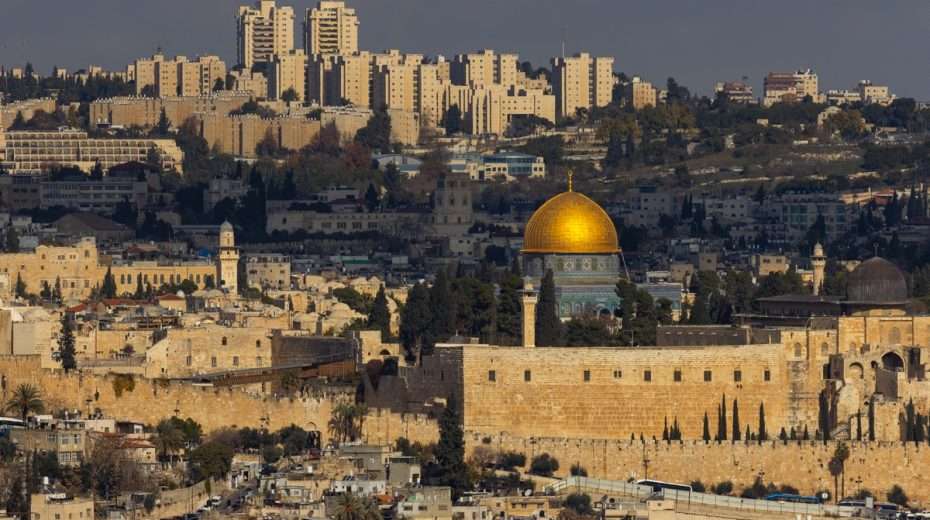Clarity on the Temple Mount
Temple deniers cannot erase the mountain of evidence showing the Jewish connection to the site.

Recently, Palestinian Authority chief Mahmoud Abbas made news when he told a special session of the UN Committee on the Exercise of the Inalienable Rights of the Palestinian People that there is no proof of a connection between the Jews and what he refers to as the Al-Aqsa mosque compound—the Temple Mount.
“They dug everywhere,” he claimed, “and they couldn’t find anything.”
This is a ludicrous statement on its face. One can only wonder how anyone, even a group as biased as this UN committee, could actually believe it.
But veracity is irrelevant. Temple deniers like Abbas make such statements because it serves their political purpose: The delegitimization of Jewish claims to Jerusalem.
If not challenged, even monumental lies such as this one can foment doubts about the historical reality of the ancient connection between Jews and the Temple Mount.
The Sunday after Abbas’ statement, Israeli Prime Minister Benjamin Netanyahu leveled such a challenge. During a cabinet meeting held at the foot of the Temple Mount in honor of Jerusalem Day, Netanyahu spoke about King Solomon, who built the First Temple, and the City of David, the heart of historical Israel, which existed 3,000 years ago.
Netanyahu could not have been expected to offer more than a brief general refutation. Yet specific facts that rebut Abbas’ and others’ lies are the only thing that can erase the effects of Temple denial.
The Western Wall in Jerusalem’s Old City is a remnant of the Temple and sometimes referred to as the Jewish people’s most sacred site. This is an error. While the Wall has great sanctity, it is the site above, where the Temple was situated, that is the holiest place for Jews.
At the foot of the southern end of the Wall is a jumble of enormous chiseled blocks. They were part of the Second Temple, thrown down by the Romans who destroyed it in 70 CE. During excavation, artifacts directly associated with these ruins were uncovered, which made it possible to identify and date the blocks.
Among these artifacts were a handful of engravings that left no doubt as to the origins of the blocks. One is a warning in Greek cautioning those who are impure not to go beyond a certain point. David Mevorach, a senior curator of archaeology at the Israel Museum, where this particular stone is displayed, said, “If we talk about the closest thing to the Temple we have … this was closest.”
It is important to remember that the Temple long predated Islam itself, which was not founded until the 7th century CE, many centuries after the Temple was destroyed. Because Muslims believe that Islam supersedes all earlier religions, mosques are frequently constructed on the sites of previously existing synagogues and churches.
Towards the end of the 7th century, during the rule of the Umayyad caliphate, the Dome of the Rock was constructed on the Temple Mount to serve as a shrine and eventually as a mosque. Based upon some very specific physical evidence, including the existence of a “foundation stone,” archaeologists and scholars have identified the Dome’s location as the site upon which the Temples stood.
The Al-Aqsa Mosque—about which we hear so much today—was constructed just a few years after the Dome of the Rock. Excavations beneath the mosque undertaken in the 1930s for renovation purposes revealed a mosaic that is believed to have been the floor of a Byzantine church.
Beneath the mosaic, a Jewish mikvah was discovered. Biblical archaeologist Leen Ritmeyer, a specialist in Temple Mount archaeology, wrote that this “proves the Jewish origin of the Temple Mount.”
This is a fraction of the evidence for the Jewish connection to the Mount. But we might also consider the testimony of Muslims themselves. Prior to the founding of modern Israel, they did not have the same obsession with denying Jewish history as they do today.
A nine-page English-language tourist guide entitled “A Brief Guide to al-Haram al-Sharif”—the Arabic name for the Temple Mount—was published by the Supreme Moslem Council in 1925. It states that the Temple Mount site “is one of the oldest in the world. Its sanctity dates from the earliest times. Its identity with the site of Solomon’s Temple is beyond dispute.”
Enough said.
________________
“We Are the Owners of Jerusalem and the Entire Land of Israel!”
Israeli government minister Itamar Ben-Gvir ascends Temple Mount in Jerusalem, insists Hamas threats will not deter any Jew.

Firebrand lawmaker Itamar Ben-Gvir ascended the Temple Mount in Jerusalem on Sunday morning in what he called a firm demonstration of Israeli sovereignty.
Ben-Gvir did not go up to the Temple Mount as planned last week on Jerusalem Day due to police concerns of a Muslim riot. A number of other Israeli lawmakers did visit Judaism’s holiest site on Jerusalem Day, and Hamas was fiercely mocked by Palestinians for failing to follow through on its threats to “defend” the Al-Aqsa Mosque from “Jewish invaders.”
“Happy to go up to the Temple Mount, the most important place for the people of Israel,” Ben-Gvir wrote in a statement shortly after the visit. “Hamas threats will not deter us, we are the owners of Jerusalem and the entire Land of Israel.”
The visit occurred early in the morning when the Temple Mount was not yet crowded with Muslim worshippers, and Ben-Gvir was surrounded by a large number of police officers and his own security agents. Even so, the officers on hand appeared stressed when Ben-Gvir stopped to read prayers from his phone.
It remains astonishing, and quite telling, that a single Jew praying at a
particular place can cause so much anxiety in Israel, so much
consternation in the international community, and so much fury among
supposedly peace-seeking Muslims.
No comments:
Post a Comment